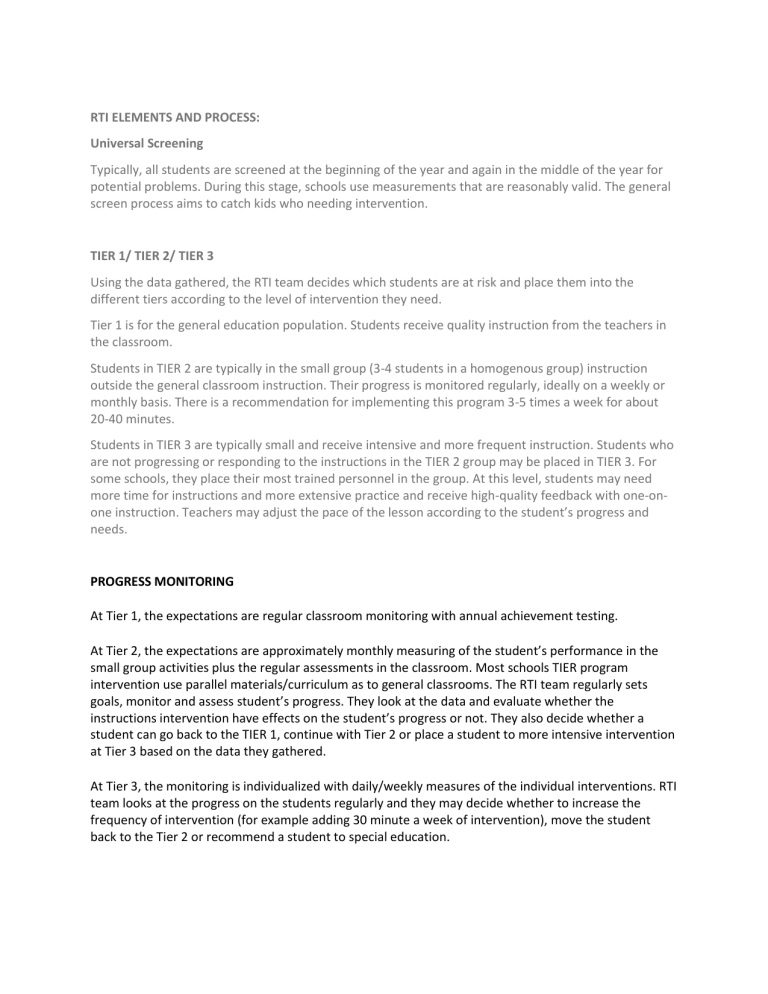
RTI ELEMENTS AND PROCESS: Universal Screening Typically, all students are screened at the beginning of the year and again in the middle of the year for potential problems. During this stage, schools use measurements that are reasonably valid. The general screen process aims to catch kids who needing intervention. TIER 1/ TIER 2/ TIER 3 Using the data gathered, the RTI team decides which students are at risk and place them into the different tiers according to the level of intervention they need. Tier 1 is for the general education population. Students receive quality instruction from the teachers in the classroom. Students in TIER 2 are typically in the small group (3-4 students in a homogenous group) instruction outside the general classroom instruction. Their progress is monitored regularly, ideally on a weekly or monthly basis. There is a recommendation for implementing this program 3-5 times a week for about 20-40 minutes. Students in TIER 3 are typically small and receive intensive and more frequent instruction. Students who are not progressing or responding to the instructions in the TIER 2 group may be placed in TIER 3. For some schools, they place their most trained personnel in the group. At this level, students may need more time for instructions and more extensive practice and receive high-quality feedback with one-onone instruction. Teachers may adjust the pace of the lesson according to the student’s progress and needs. PROGRESS MONITORING At Tier 1, the expectations are regular classroom monitoring with annual achievement testing. At Tier 2, the expectations are approximately monthly measuring of the student’s performance in the small group activities plus the regular assessments in the classroom. Most schools TIER program intervention use parallel materials/curriculum as to general classrooms. The RTI team regularly sets goals, monitor and assess student’s progress. They look at the data and evaluate whether the instructions intervention have effects on the student’s progress or not. They also decide whether a student can go back to the TIER 1, continue with Tier 2 or place a student to more intensive intervention at Tier 3 based on the data they gathered. At Tier 3, the monitoring is individualized with daily/weekly measures of the individual interventions. RTI team looks at the progress on the students regularly and they may decide whether to increase the frequency of intervention (for example adding 30 minute a week of intervention), move the student back to the Tier 2 or recommend a student to special education. With RTI, most school that I have read about or watched have seen reduced number of kids that are sent to special education. RTI is not meant to replace special education but rather screen students who are falling behind as early as possible. https://us.corwin.com/sites/default/files/upm-assets/34841_book_item_34841.pdf WHEN? WHERE? HOW IT IS IMPLEMENTED? Looking at the different resources I found, some schools implement TIER 2 & TIER 3 instructions at varying times in the school depending on their schedules and resources. Some schools, schedule an Intervention block in the morning for one hour. Some school pulls their kids out during the elective classes, but not from the core classes. RESOURCES: Here is the list of resources I gathered about RTI with some notes for quick references. https://docs.google.com/document/d/1Q3Bm680WoKQckzTA3Ha9CS0nlMHaEFZ/edit?usp=sharing&ouid=102118192288025224790&rtpof=true&sd=true

